Lunenburg Heritage
Homes
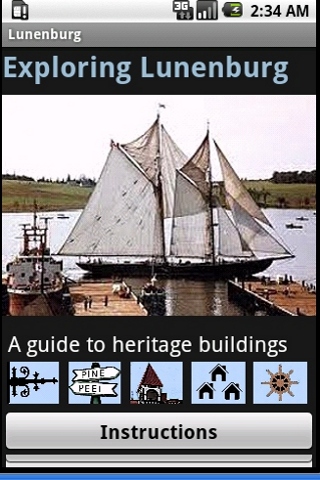
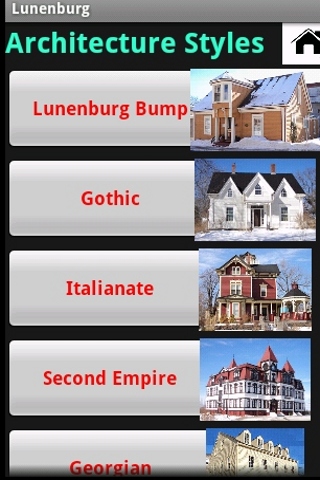
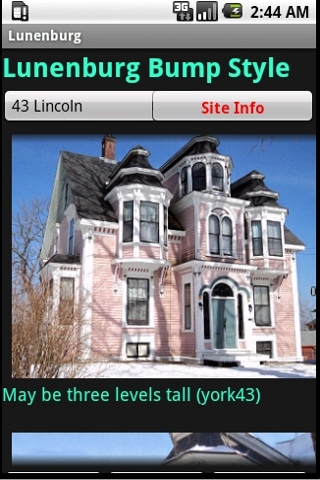
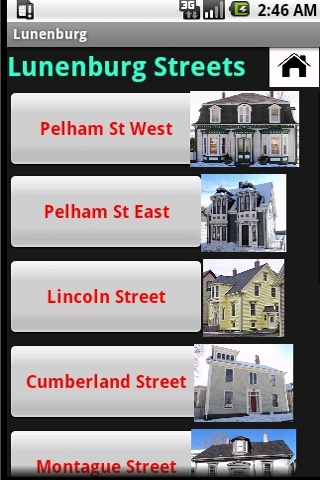

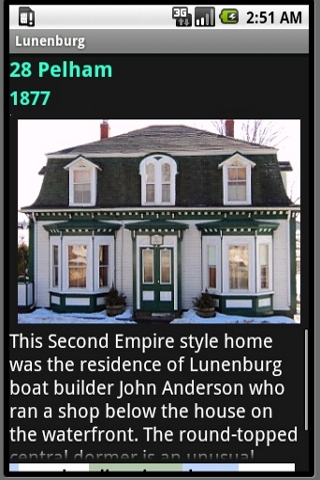
This app is a feature-filled walking tour guide to 160 heritage
buildings
in the Old Town of Lunenburg, Nova Scotia, which is a UNESCO World
Heritage Site on account of its unusual and old residential architecture.
Each site has a photo and description. There are visual references
to
architectural styles, sliding panoramas of the major streets, a
recommended route, and links to reviews of local restaurants and
accommodation. Also a feature allows automatic retrieval of nearby real
estate listings.
The app shows your location in real time over a satellite view map
image.
Clicking an icon brings up a description of the nearest interesting
building to where you are standing.
The app can be used remotely to study Lunenburg from afar and
links with
StreetView.
The initial release of this app is designed to run on a phone with a large (min 480 x 800
pixels,
3.7 inch) touchscreen, running Android 2.1 or higher.
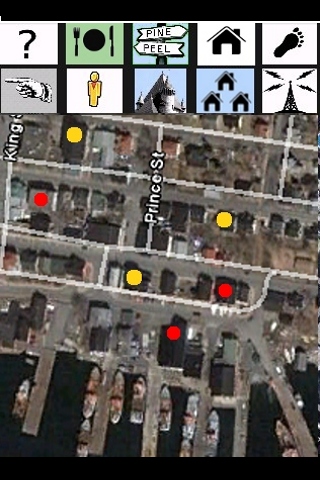
INSTRUCTIONS ON USING THE APP
The opening page of the app has five icons which when clicked lead
to various types of background reference material.
SITES
The first icon points to a page with all the homes
listed. They can be searched by address, street or architect.
STREETS
The second icon points to a list of the streets in the
Lunenburg where the homes are located.
STYLES
The third icon directs to a listing of the early
architectural styles represented in Lunenburg.
REAL ESTATE
The fourth icon leads to a list of real estate listings for all of
Lunenburg.
HISTORY
This leads to a brief description of Lunenburg's
history.
Below the five reference icons, there are two buttons. The upper
one leads to this instruction page.
The button Start Lunenburg Tour leads to the important map
page of the app.
THE MAP PAGE
The Map Page opens at a location centred at
the Fisheries Museum on the Lunenburg waterfront. By default the
map is in satellite view and resembles an aerial photograph. The yellow
circle dot below the centre of the map represents the site of one of the
homes. The color and size of the circle indicate the significance of
the home. The most important are marked in larger yellow circles followed
by slightly smaller yellow circles for the next tier of homes. Lesser
homes are marked in orange and minor homes in red. Clicking exactly on a
circle causes the home's name to appear in red letters.
The Map Page has ten icons in two rows along the top. Four of
these icons are familiar from the previous home page and serve the same
function as before.
There are six new icons on the Map Page:
DESCRIPTION OF NEAREST SITE
The question mark icon brings up the description page for the closest
home to the map centre. If it clicked a second time, the next closest
house is described, and so on.
TOUR SHOWN
Clicking the pointing hand icon causes a recommended
walking route to be displayed in blue. The icon turns blue at the same
time. Clicking it a second time removes the blue route from the map.
STREET VIEW
The small yellow man icon brings up the Google Street View for that
location, assuming that it exists as the views apply only to a narrow
strip along some, but not all Lunenburg streets.
PLACES TO EAT
The Plate icon brings up the Yelp website with reviews of
Lunenburg restaurants.
LOCATION BUTTONS
The last two icons on the right have
important and powerful functions which rely on the GPS locations.
SHOW PATH
Clicking the footprint icon causes your route to be
recorded and drawn as a yellow line path over the map as you move around.
Every twenty seconds or so, the phone checks your actual position using
GPS satellites and updates the route.
After this button is clicked, it turns red to indicate that your path
is now being drawn. The numbers alongside show distance from the start.
TURN ON GPS
The important radio tower icon brings the centre of
the map to align with your actual location. This tower icon must be
activated in red for the route mapping (the footprint icon) and also for
the Nearest Site query (the question mark icon at the upper left) to
work properly.
Before this feature will work properly without crashing the app,
the phone needs to have established a connection with the GPS satellite
signal. Before starting the app, you must check your settings on the main
phone page to make sure that the Location is set to use GPS satellites.
Establishing an initial connection may take a moment or two. You can open the built in Google Maps application to
see if the location is known. It will display as a blue triangle in the
center of the Maps screen as soon as a connection is established. After
this occurs, all aspects of the Lunenburg Tour app should work
just
fine.
FUNDY MINERAL COLLECTING AND OTHER APPS






